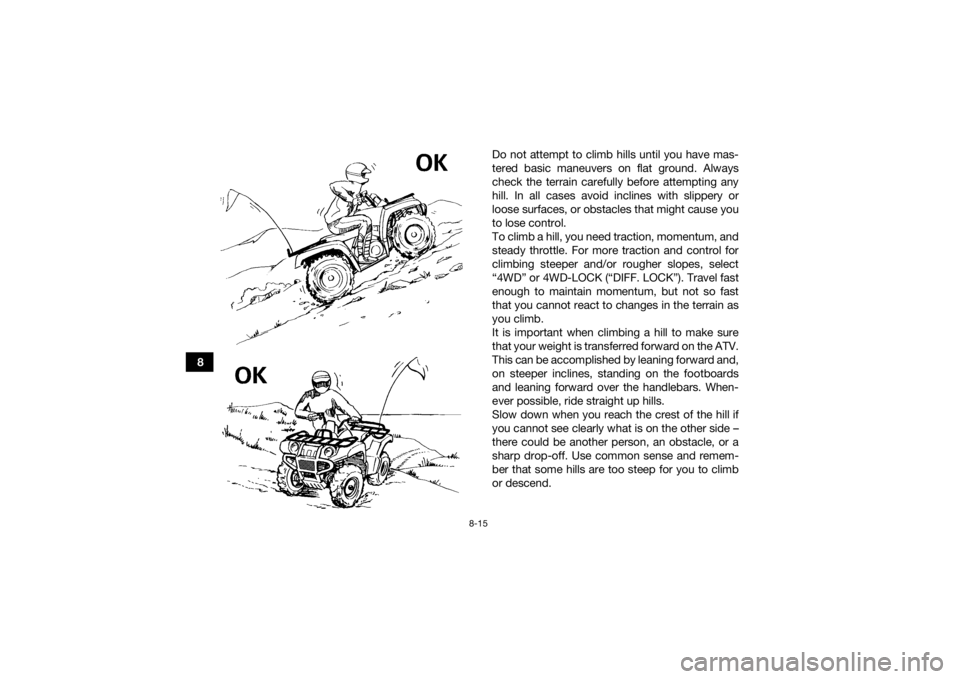Page 83 of 176
8-8
8
Avoid wheelies and jumping.
WARNING! At-
tempting wheelies, jumps, and other stunts in-
creases the chance of an accident, including
an overturn. Never attempt stunts, such as
wheelies or jumps. Don’t try to show off.
[EWB01482]
Modifications and accessories
Never modify this ATV through improper installa-
tion or use of accessories or other modification. All
parts and accessories added to this ATV should
be genuine Yamaha or equivalent components
designed for use on this ATV and should be in-
stalled and used according to instructions. If you
have questions, consult an authorized ATV dealer.
WARNING! Operating this ATV with improper modifications may cause changes in handling
which in some situations could lead to an acci-
dent.
[EWB01492]
UBLT60E0.book Page 8 Tuesday, July 13, 2021 9:16 AM
Page 89 of 176

8-14
8
may continue to go straight. If the ATV doesn’t
turn, come to a stop and then practice the proce-
dure again. If the riding surface is slippery or
loose, it may help to position more of your weight
over the front wheels by moving forward on the
seat.
Once you have learned this technique, you should
be able to perform it at higher speeds or in tighter
curves.
Improper riding procedures such as abrupt throt-
tle changes, excessive braking, incorrect body
movements, or too much speed for the sharpness
of the turn may cause the ATV to tip. If the ATV be-
gins to tip over to the outside while negotiating a
turn, lean more to the inside. It may also be nec-
essary to gradually let off on the throttle and steer
to the outside of the turn to avoid tipping over.
Remember: Avoid higher speeds until you are
thoroughly familiar with the operation of your ATV.
CLIMBING UPHILL
WARNING
EWB01672Climbing hills improperly can cause overturns
or loss of control. Use proper riding techniques
described in this Owner’s Manual.
Never operate the ATV on hills too steep for
the ATV or for your abilities. The ATV can
overturn more easily on extremely steep hills
than on level surfaces or small hills.
Always check the terrain carefully before you
start up any hill. Never climb hills with exces-
sively slippery or loose surfaces.
Shift your weight forward.
Never open the throttle suddenly. The ATV
could flip over backwards.
Never go over the top of any hill at high
speed. An obstacle, a sharp drop, or another
vehicle or person could be on the other side
of the hill.
Never attempt to turn the ATV around on any
hill until you have mastered the turning tech-
nique as described in the Owner’s Manual on
level ground. Be very careful when turning
on any hill.
Avoid crossing the side of a steep hill if pos-
sible. When crossing the side of a hill, shift
your weight to the uphill side of the ATV.
UBLT60E0.book Page 14 Tuesday, July 13, 2021 9:16 AM
Page 90 of 176

8-15
8Do not attempt to climb hills until you have mas-
tered basic maneuvers on flat ground. Always
check the terrain carefully before attempting any
hill. In all cases avoid inclines with slippery or
loose surfaces, or obstacles that might cause you
to lose control.
To climb a hill, you need traction, momentum, and
steady throttle. For more traction and control for
climbing steeper and/or rougher slopes, select
“4WD” or 4WD-LOCK (“DIFF. LOCK”). Travel fast
enough to maintain momentum, but not so fast
that you cannot react to changes in the terrain as
you climb.
It is important when climbing a hill to make sure
that your weight is transferred forward on the ATV.
This can be accomplished by leaning forward and,
on steeper inclines, standing on the footboards
and leaning forward over the handlebars. When-
ever possible, ride straight up hills.
Slow down when you reach the crest of the hill if
you cannot see clearly what is on the other side –
there could be another person, an obstacle, or a
sharp drop-off. Use common sense and remem-
ber that some hills are too steep for you to climb
or descend.
UBLT60E0.book Page 15 Tuesday, July 13, 2021 9:16 AM
Page 92 of 176

8-17
8
Always check the terrain carefully before you
start down any hill.
Never operate the ATV on hills too steep for
the ATV or for your abilities. The ATV can
overturn more easily on extremely steep hills
than on level surfaces or small hills.
Shift your weight backward and to the up
side of the hill.
Never go down a hill at high speed.
Avoid going down a hill at an angle that
would cause the ATV to lean sharply to one
side. Go straight down the hill where possi-
ble.
Improper braking can cause the wheels on
the uphill side to come off the ground or
cause loss of traction. Apply brakes gradual-
ly. If in “2WD”, apply only the rear brake.
When riding your ATV downhill, shift your weight
as far to the rear and uphill side of the ATV as pos-
sible. Move back on the seat and sit with your
arms straight. Engine compression will do most of
the braking for you. For maximum engine com-
pression braking effect, select the low-range posi-
tion and change to “4WD” before beginning to
descend the hill. Use caution while descending a hill with loose or
slippery surfaces. Braking ability and traction may
be adversely affected by these surfaces. Improper
braking may also cause a loss of traction.
When this ATV is in “4WD”, all wheels (front and
rear) are interconnected by the drive train. This
means that applying either the front brake or the
rear brake will brake all wheels. When descending
hills, using either brake lever or the brake pedal
will brake the wheels on the downhill side. Avoid
sudden application of either the front or rear brake
because the wheels on the uphill side could come
off the ground. Apply both the front and rear
brakes gradually.
Whenever possible, ride your ATV straight down-
hill. Avoid sharp angles which could allow the ATV
to tip or roll over. Carefully choose your path and
ride no faster than you will be able to react to ob-
stacles which may appear.UBLT60E0.book Page 17 Tuesday, July 13, 2021 9:16 AM
Page 105 of 176

9-6
9
3*Rear brake • Check operation and correct if necessary.
• Check brake pedal free play and adjust if neces-
sary.
• Check fluid level and ATV for fluid leakage, and correct if necessary. √√√√√
• Replace brake pads. Whenever worn to the limit
4 *Brake hoses • Check for cracks or other damage, and replace if
necessary. √√√√
• Replace. Every 4 years
5 *Brake fluid • Change. Every 2 years
6 *Wheels • Check runout and for damage, and replace if nec-
essary. √ √√√
7 *Tires • Check tread depth and for damage, and replace if
necessary.
• Check air pressure and balance, and correct if necessary. √ √√√
8 *Wheel hub bearings • Check for looseness or damage, and replace if
necessary. √ √√√
9 *V- b e l t • Check for wear, cracks or other damage, and re-
place if necessary. √ √√√
10 *Chassis fasteners • Make sure that all nuts, bolts, and screws are
properly tightened. √√√√√
NO.
ITEM CHECK OR MAINTENANCE
JOB INITIAL
EVERY
Whichev- er comes first month136612
km (mi) 240
(150) 1300
(800) 2500
(1600) 2500
(1600) 5000
(3200)
hours 15 80 160 160 320
UBLT60E0.book Page 6 Tuesday, July 13, 2021 9:16 AM
Page 106 of 176

9-7
9
11*Shock absorber as-
semblies • Check operation and correct if necessary.
• Check for oil leakage and replace if necessary.
√√√
12 *Stabilizer bushes • Check for cracks or other damage, and replace if
necessary. √√√
13 *Rear knuckle pivots • Lubricate with lithium-soap-based grease. √√√
14 *Steering shaft • Lubricate with lithium-soap-based grease. √√√
15 *Steering system • Check operation and repair or replace if dam-
aged.
• Check toe-in and adjust if necessary. √√√√√
16 *Engine mounts • Check for cracks or other damage, and replace if
necessary. √√√
17 *Axle boots • Check for cracks or other damage, and replace if
necessary. √√√√√
18 Engine oil • Change.
• Check ATV for oil leakage, and correct if neces-
sary. √ √√√
19 Engine oil filter car-
tridge • Replace.
√√√
20 Differential gear oil • Change.
• Check ATV for oil leakage, and correct if neces-
sary. √√
NO.
ITEM CHECK OR MAINTENANCE
JOB INITIAL
EVERY
Whichev-
er comes first month136612
km (mi) 240
(150) 1300
(800) 2500
(1600) 2500
(1600) 5000
(3200)
hours 15 80 160 160 320UBLT60E0.book Page 7 Tuesday, July 13, 2021 9:16 AM
Page 107 of 176
9-8
9
EBU23072TIPSome maintenance items need more frequent service if you are riding in unusually wet, dusty, sandy or
muddy areas, or at full-throttle.21 Final gear oil • Change.
• Check ATV for oil leakage, and correct if neces-
sary. √√
22 Cooling system • Check coolant level and ATV for coolant leakage,
and correct if necessary. √√√√√
• Replace coolant. Every 2 years
23 *Moving parts and
cables •Lubricate.
√√√√
24 *Throttle lever • Check operation.
• Check throttle lever free play, and adjust if neces-
sary.
• Lubricate cable and lever housing. √√√√√
25 *Front and rear
brake switches • Check operation and correct if necessary.
√√√√√
26 *Lights and switches • Check operation and correct if necessary.
• Adjust headlight beams. √√√√√
NO.
ITEM CHECK OR MAINTENANCE
JOB INITIAL
EVERY
Whichev- er comes first month136612
km (mi) 240
(150) 1300
(800) 2500
(1600) 2500
(1600) 5000
(3200)
hours 15 80 160 160 320UBLT60E0.book Page 8 Tuesday, July 13, 2021 9:16 AM
Page 108 of 176
9-9
9
Hydraulic brake service
• Regularly check and, if necessary, correct the brake fluid level.
• Every two years replace the internal components of the brake master cylinders and calipers, and
change the brake fluid.
• Replace the brake hoses every four years and if cracked or damaged.
UBLT60E0.book Page 9 Tuesday, July 13, 2021 9:16 AM